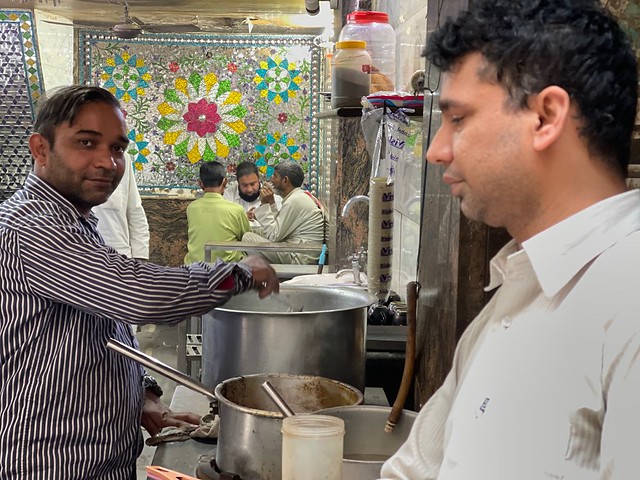
City Hangout – Sheesh Mahal Tea House, Farash Khana

Glasses of chai.
[Text and photos by Mayank Austen Soofi]
The imperial evening in the Palace of Mirrors is already strained to begin with. And then the rebel-courtesan gets more and more mutinous in her dance. She even picks up a knife from the fruit platter. Within moments, the smirking woman multiplies into a multitude of mirrored images. One Anarkali is now a thousand offending Anarkalis, infuriating Emperor Akbar to indescribable rage.
This famously thrilling scene in the classic 1960 movie Mughal-e-Azam was filmed in a Mumbai film set in which the makers painstakingly recreated the legendary Sheesh Mahal of Lahore Fort. The wall, as in the original 17th century Sheesh Mahal, was made of thousands of decorative glass tiles, or the sheesh.
A similar Sheesh Mahal, as in Lahore, also exists in Agra Fort. One historic Sheesh Mahal is in Delhi, too, in Shalimar Garden, where Aurangzeb was crowned as the sixth Mughal emperor. It is in ruins, with no trace of its original splendour. Then there is one more Sheesh Mahal in the capital, with a wall panelled with hundreds of small glass tiles. This so-named Sheesh Mahal is a little-known chaikhana, or teahouse, in Farash Khana. The atmospheric locality in Old Delhi is a labyrinth of congested by-lanes, each of which is a universe so self-contained with its many landmarks that one can perhaps spend a lifetime within its limits without yearning for the world outside.
This afternoon only three customers are in the dimly lit teahouse. They all are backbenchers, withdrawn towards the wall embossed with multi-coloured glasses. Two of these men are sitting by a panel whose central motif appears to be the likeness of a flower. The glass petals in the middle are in deep pink, surrounded with glass leaves of silver, yellow and green. An artistically minded person might recall Vincent Van Gogh’s sunflowers. Indeed, if the penniless Dutch painter were to live in contemporary Old Delhi, he might have liked the ambience of this tea house and lingered here everyday (much like that barefoot painter MF Husain who favoured a tea house in Hazrat Nizamuddin Basti during the 1960s).
Sheesh Mahal is managed by young Sajid whose grandfather, Mange Mian, had founded it 30 years ago. It is no accident that the sheeshas occupy a prominence in the tea house, he explains. “My family deals with sheeshe ka kaam (mirror work).” Minutes later, the friendly man gets busy making a cup of customised chai for a fussy customer who demands his tea to have “less sugar, less milk and no malai”, which is basically the antithesis of the chai idealised in Sheesh Mahal.
The place serves daily from 4 am to 1 am.
Tea in the palace of Mirrors
1.
2.
3.
4.
5.
6.
7.








And who this ‘fussy customer’ is who demands such unromantic glass of chai?